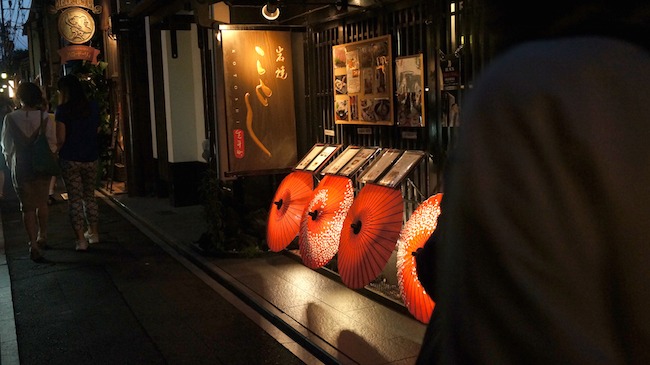
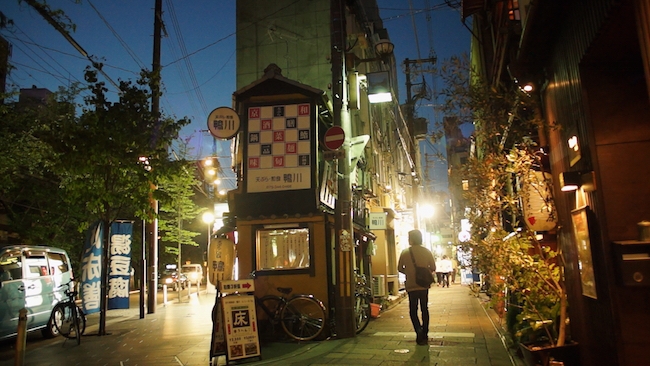
In Part Two of his article on challenging assumptions about filming, Craig Marshall offers futher insights after two weeks shooting in Japan using his extremely portable home-brew set-up.
[You can read Part One of this article here: Challenging "traditional" assumptions about cameras, lenses, recorders, dynamic range, etc]
As you'll realise by now, I'm from the 'old school' of independent film and television production so I'm comfortable with fully manual lenses and I like cameras with knobs and dials in the right place too, but one feature that my modern video camera enjoys and one I've come to appreciate is the 'Auto Gain' user option. This allows the operator to fix the shutter and iris for creative effect whilst allowing the camera's electronics to adjust exposure by adding or subtracting Gain 'as required'. A manually operated 'thumb wheel' located right where you need it, on the side of the camera can be programmed to override the internal electronics by +/- 2 stops in real time.
For night shots in Australia, I'd normally lock the camera's shutter to 1/50th for a PAL-based camera shooting at 25fps but in NTSC Japan with its 60Hz mains supply, I've found a shutter speed of 1/40th of a second perfectly synchronises the camera's electronic shutter to the AC mains so street light flicker is completely eliminated. The longer exposure increases motion blur so camera movement needs to be exercised with caution but on the plus side, this technique offers a little bit more light to the sensor.
For my Kyoto evening shots, I locked the shutter at 1/40th, set my lens' iris manually to give me the depth of field I wanted for the particular shot then let the camera decide its most appropriate Gain setting for the given lighting and lens combination. I could then use the thumbwheel to manually 'trim' the camera's 'Auto Gain' selection to keep potentially blown highlights under control. Of great benefit here too is my 'Digicon' filter from Schneider Optics which is designed to reduce highlights by up to one stop whilst lifting the shadows a corresponding amount. The Digicon perform this remarkable feat without softening the image or upsetting the colour balance.
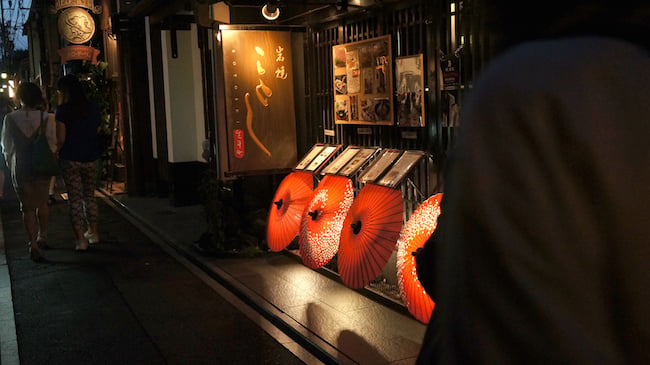
Kyoto’s Gion district entices photographers with tiny Riverside restaurants and occasional Geisha glimpses!
Now as Roland's article hints, 'Gain' is an interesting subject. How do you measure and compare a particular camera's native sensitivity? In my case, if I set the camera's Gain to 0dB, I assume the electronics are not excessively amplifying the signal off the sensor. My camera is a video/stills hybrid so if I switch the 'video' camera over to shoot RAW 5K stills using all the pixels off the native 3:2 format sensor and with an identical 'stills' exposure of 1/50th of a second shutter speed, the system reveals an ISO of about 100. Now, you could say the camera is not particularly sensitive but here's the biggie, I regularly shoot at night with up to 18dB of Gain dialled in and whilst the pictures are considerably brighter, they show virtually no noise in the blacks. My camera's Gain can be set as high as +30dB but if 0dB is roughly ISO 100, then my tests indicate 18dB Gain represents the equivalent of about ISO 1600. Of course, shooting ProRes in 4:2:2 colour space (instead of the camera's native LongGOP 4:2:0) certainly helps shadow noise here but I've tested some DSLRs where even +12dB of Gain resulted in unacceptably noisy pictures. Perhaps one man's 0dB can be another man's Plus 12?
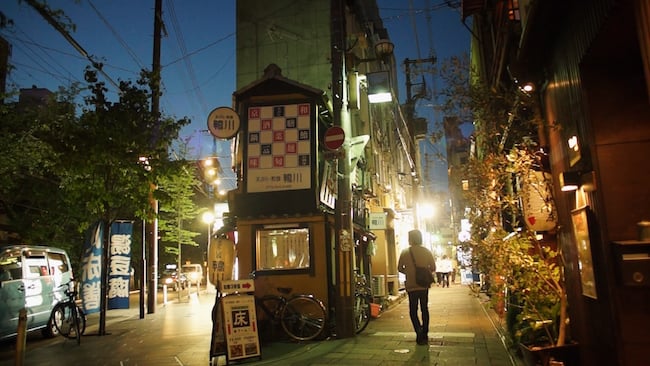
Even with 30dB of gain applied, (ISO 3200) this HD ProRes 422 frame grab stands up quite well
Roland asked: "There are also the basic ergonomics of the camera: how does it balance on the shoulder, can you operate in cramped conditions, are there controls that keep getting jogged because they are in the wrong place? How many menu steps do you have to go through to for the most common adjustments? Are any of the picture pre-sets of any use at all?”
This has always been my argument against shooting video on DSLRs. As much as I admire their compactness, their internal electronics and the value for money the format seems to offer, a DSLR form factor is simply the wrong shape to shoot video without additional rigging. This need has spurned a massive online market in camera accessories and we’ve probably all been guilty of going there from time to time. I’ll admit I have but as anybody who has shot with a balanced and well designed ENG camera knows, the ‘video’ form factor offers a couple of distinct advantages, the main one being the natural stabilization afforded by the shape of the forearm and elbow when connected to a heavy but balanced shoulder camera: there’s a natural three point stabilization system there, formed from the triangle created around forearm and elbow.
Finally, Roland concluded: “...Cinematography in the end is not about making beautiful pictures or capturing reality but telling stories; cameras and the all the rest of the equipment we use are just a means to that end.”
Well, ain’t that just so true!
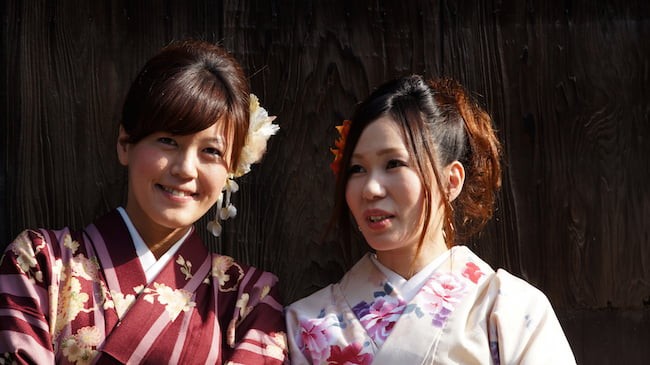
Young Japanese ladies enjoy dressing in traditional costume when visiting Kyoto’s many Temples
Stop Press!
I’ve just managed to acquire the ‘holy grail’ of Zeiss ‘Contax’ lenses and one which virtually completes my collection of Zeiss ‘vintage’ primes: the coveted Distagon T* f2.8 - 21mm wide angle. Although Zeiss has recently re-manufactured this classic super wide for newer mounts and have included electronic aperture control in their latest incarnation, the original and fully manual C/Y mount Contax full frame version still commands a premium price around the world. The relatively massive lens weighs in at over half a kilogram and consists of fifteen elements in thirteen groups but even so, why is this particular lens so special? Why are many prepared to pay more than the price of a new Sony A7s for a twenty year old lens with no Auto Focus, no Auto Iris and no Internal Stabilization?
You’ll note that by today’s standards, a speed of F2.8 is not particularly fast but this is one super wide lens which over the past twenty years or so has attracted a cult following. Why, because you can confidently shoot with it at maximum aperture where you’ll enjoy sharp focus with no chromatic aberration from about a metre away to infinity. Stop down a bit and you’ll enjoy a depth of focus from the front glass to forever!
Unlike most other super wide primes or zooms, the Zeiss 21mm will pass the entire colour gamut right out to the corners showing only marginal vignetting and barrel distortion and these are really only measurable at maximum aperture. When pushed, the lens exhibits a creamy white and very ‘filmic’ flare which is well controlled and probably a tribute to the Zeiss T* coating, the same as found on the company’s legendary CP2 cinema lenses of the time. The Zeiss 21mm super wide enjoys a Field of View of 92 degrees with absolutely no ‘fisheye’ effect so this lens virtually sees what your eyes see and with a focus rotation of nearly 150 degrees, (in the right direction) the overall length of the lens remains absolutely constant, nor does the front element rotate.
For a ‘cinema verite’ style of photography on the streets at night, with F2.0 at the sensor after the Speed Booster and with restored full frame width on the Super 35 sensor, this lens has just become my new best friend!
Tags: Production


Comments